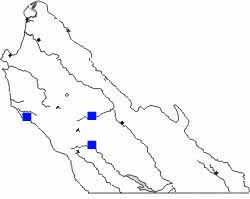| |
|
|
BISON
SNAKETAIL
Ophiogomphus
bison
|
|
In the spring, along rushing rivers
cascading out of the Santa Lucia Mountains, a lucky observer might find
one of the most fascinating odes in Monterey County: the Bison
Snaketail. Males sit on rocks out in the rapids (below) but only the
female has the tiny pair of bison-like 'horns' atop the head (above).
|
|
|
|
|
|
|
|
Bison Snaketail is one of four species of
snaketail in California, but the only one in MTY. Males have expanded
'clublike' tips to the abdomen (like a cobra hood) and the abdomen is a
colorful yellow and black. Bison Snaketail has a bright green throax
with a broad dark-brown stripe across the side. Males sit on rocks in
the current, waiting for females or disputing other males, often with
raised abdomens.
|
|
|
|
Before 2007, there were only two records of
Bison Snaketail in Monterey County. P.H. Arnaud, Jr., collected singles
on successive days at "Big Sur State Park" on 19 & 20 June 1949. It
is assumed this was Pfeiffer-Big Sur State Park, and presumably the
snaketails were along the Big Sur River. The first one, a female in
poor condition on 19 June 1949, is now #8934 in the collection at
Illinois State University. The second is now held at the California
Academy of Sciences, San Francisco. [Thanks
toTim Cashatt, curator at Illinois State Univ., and Tim Manolis for
these details.]
In Apr-May 2007, populations of Bison
Snaketail were discovered along the Arroyo Seco and upper San Antonio
Rivers (D. Roberson et al.). The species may be present along all the
major rivers running out of the Santa Lucia Mountains.
Photos
of males (above) 28 Apr & 5 May 2007 Arroyo Seco River
Photos of female (below) 12 May 2007 North fork San Antonio River
|
|
|
|
 |
Females may occur rather far from water,
perched in the woods (like this one left, above, and below). They have
a gorgeous pattern of yellow, green, and brown to go with the yellow
face and gray eyes. Females have the tiny pair of 'horns' atop the head
for which this species is named. In a very close look (the top photo on
this page), note that each 'horn' is topped with black although the
base and 'platform' for the 'horns' is bright orange-yellow.
A character of snaketails that helps to
distinguishe them from Pacific Clubtail, which can occur in the same
habitat, is the pale stripe on the thighs of the rear legs. The
clubtail has all-black legs.
|
|
|
|
|
 The map shows the currently
known locations for Bison Snaketail in MTY: along the Big Sur, Arroyo
Seco, and upper San Antonio rivers. The Big Sur specimens were back in
949, so whether they still occur there is not yet known. The species
occurs on gravel bars in rivers throughout the foothills of both the
Sierran and Coast ranges of northern California. MTY is its
southernmost known locale in the Coast Range [it occurs south to Tulare
Co. in the Sierra Nevada]. The map shows the currently
known locations for Bison Snaketail in MTY: along the Big Sur, Arroyo
Seco, and upper San Antonio rivers. The Big Sur specimens were back in
949, so whether they still occur there is not yet known. The species
occurs on gravel bars in rivers throughout the foothills of both the
Sierran and Coast ranges of northern California. MTY is its
southernmost known locale in the Coast Range [it occurs south to Tulare
Co. in the Sierra Nevada].
Though flight dates ranges from
April-October, it is said to be most common from May to July (Manolis
2003). The known dates in MTY are 28 Apr-20 June.
|
|
|
Literature cited:
- Manolis, T. 2003. Dragonflies and Damselflies of
California. Univ. of
Calif.
Press, Berkeley.
Web resources:
Major identification web sites with much information on California
odes include:
For sites with excellent photos to compare for identification or to
simply
enjoy, see:
Many of these sites have links to other useful pages. Kathy Biggs's
site
is particularly useful in her selection of links. |
|
All photos © Don Roberson 2007
TOP
|
|
|
Page created 8 Mar 2007,
updated 16 May 2007
|
|
|
|
|
